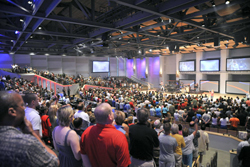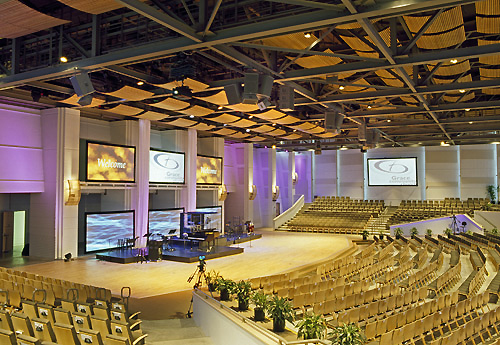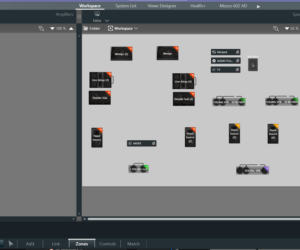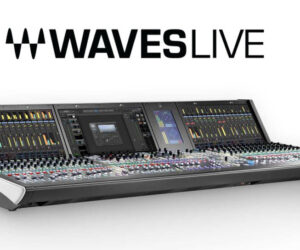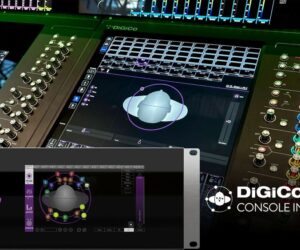The South Auditorium of Grace Community Church reveals a striking vision of what worship spaces of the future might look like—and sound like. Within this new, extraordinarily adaptable 1,650-seat space in suburban Indianapolis, Ind., a zero-level platform, reconfigurable wrap-around seating, and 360-degree theatrical lighting allow multiple visual and inter-relational effects.
Delivering sound for this space, Meyer Sound’s Constellation electroacoustic architecture works hand-in-glove with a collection of Meyer Sound loudspeakers to afford both flexibility and intimacy in creating harmonious aural experiences.
For Architect Kevin Callahan of Callahan Studios in Scottsdale, Ariz., the foundational design goal was to work with spatial relationships, color, images and sounds as fluid palettes for creating sensory environments to enable full congregational participation.
“Isn’t worship supposed to be participation, not merely a performance? I believe so, and that’s why I designed the architecture here as a giant, three-dimensional hug,” says Callahan. “Constellation supports that effect by allowing the congregation to sense their active participation.”
From the outset of the design process, Callahan collaborated on all aspects of acoustics and production technology with Vance Breshears and Jeff Miller of Sound Technology Consultants (STC) in El Cajon, Calif., as well as with the church’s Senior Pastor Dave Rodriguez and Senior Director of Production Daryl Cripe. The contractor was The Spectrum Group of Oklahoma City.
Older churches with highly reverberant acoustics foster a feeling of connectedness, observes Miller, but it has been largely sacrificed in multiuse houses of worship built over the last few decades.
“Rooms were made dead for voice intelligibility and amplified music, but for the congregation it was like singing into a pillow. By switching on Constellation we can bring back the experience of a community worshipping together, while switching it off provides optimum acoustics for amplified music.”
The second main benefit of Constellation, as noted by Cripe, is the capability to tailor the room’s acoustics with multiple presets for any style of music. “We do everything. In one service we can have a full-on rock set, then classical style strings, and a choir. We go all over the board, which is why we love what Constellation will do for us.”
Constellation electroacoustic architecture creates natural acoustical ambiences through carefully balanced and selective enhancement of early reflections and later room reverberation.
At Grace Community Church, the Constellation system comprises a primary communications processor and four VRAS processors. Room reverberation zones are allocated for the left, center, and right sections of the room, and a fourth VRAS processor generates early reflections from the stage to the house.
The system employs a total of 30 microphones and 89 Meyer Sound loudspeakers positioned on walls and overhead. Loudspeaker models used include 57 of the tiny MM-4XP miniature loudspeakers, 16 compact UPM-1P loudspeakers, and six UMS-1P subwoofers.
The main system required exceptional flexibility in design, as it must support use of the room in multiple configurations, including temporary proscenium and in-the-round. The digitally cross-matrixed LCR system features four CQ-1 and nine CQ-2 loudspeakers as the main cabinets, with 14 UPJ-1P VariO loudspeakers for the delay ring and six M1D-Sub subwoofers for low-frequency support.
“It was our desire from the beginning to have an all-Meyer system,” states Cripe, “and over the months since opening, the performance has been flawless.”
Though he has received numerous compliments on the quality and clarity of the main PA, Cripe has noticed—to his satisfaction—that few in the congregation seem to be aware of the enhancements from Constellation.
.
“It doesn’t sound artificial or electronic, and the effect is absolutely natural for the dimensions of the room,” he observes. “Yet people tell us that they can hear things better, that they enjoy the congregational singing more, that they feel energized by their participation. That lets us know it’s working great.”
For Callahan, the integral role of Constellation at Grace Community Church sets the stage for even more creativity and congregational participation. “Total adaptability in worship is what the next generation will be seeking to explore,” he predicts.
“The Constellation system actually affords the adaptability in the sonic domain. In the future, any time the creative arts team says we want to do this or that with sound, chances are they will be able to do it, thanks in large part to Constellation.”


